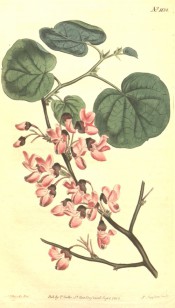Cercis siliquastrum L.
Fully-hardy, spreading, sometimes multi-stemmed, deciduous tree with inversely heart-shaped leaves, bronze when young, changing to blue-green, then turning yellow in autumn. The clusters of magenta, pink or white flowers are borne before and with the leaves. To 10m. [RHSE, Hortus, Hilliers’].
Horticultural & Botanical History
‘There are more original figures of this tree among the older Botanists, than usually occur. For the most part their wooden cuts are copied from one another, and not unfrequently, to illustrate the works of different authors, the same blocks were used indiscriminately, where the same booksellers were employed, so that it would often be a very difficult task to find out to whom the original drawings belonged. There are no less than six different wooden cuts of this tree, without reckoning the one of Castor Durante, which is in fact copied from Lobel, with the addition of the figure of Judas suspended from one of the branches, thus announcing the origin of its name of Arbor Judae, from the popular tradition, that it was on this tree that the traitor sought to rid himself of the remorse his crimes had occasioned.’ [BM t.1138/1808]. Introduced to Britain in 1596. [PD].
History at Camden Park
Listed in all published catalogues [T.294/1843].
Notes
Published Dec 13, 2009 - 03:30 PM | Last updated Jul 18, 2010 - 05:00 PM
| Family | Fabaceae |
|---|---|
| Category | |
| Region of origin | South East Europe to South East Asia |
| Synonyms | |
| Common Name | Judas tree |
| Name in the Camden Park Record |
Cercis siliquastrum - Judas tree |
| Confidence level | high |


